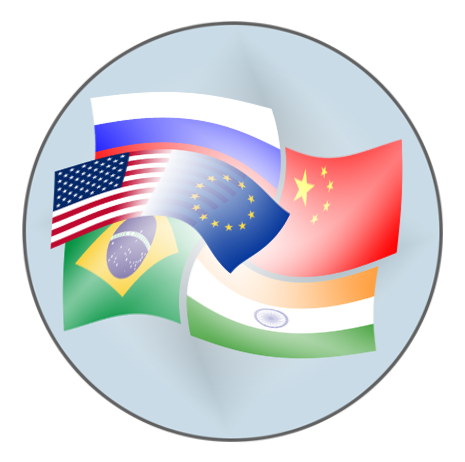At first, it seemed that the machine had tilted, its levers, bells and flippers having hit some kind of glitch, causing us to lose the ball and the bonus points.
 As the curtain rises on the second decade of the twenty-first century, we will see that the machine is actually fine, but it’s become a different game. Quite entirely. To put it mildly, “the economy” is proving to be quite a drama, its pungence largely dependent on where your company or career is wired into it. Although it is quite frowned upon in the U.S. to admit despair, some pundits have even flirted with the moniker, “The Great Recession” to describe the crisis, a faint nod to the Great Depression of the 1930s, but this comparison is off-base. As I have argued for some time, the 2007-2010 “financial crisis” has played a mere overture to the real story, a transformation of the global “economic architecture.” I first heard this deft phrase from His Excellency Shri Kamal Nath, India’s very diplomatic Minister of Commerce in 2008 (coverage here). As the curtain rises on the second decade of the twenty-first century, we will see that the machine is actually fine, but it’s become a different game. Quite entirely. To put it mildly, “the economy” is proving to be quite a drama, its pungence largely dependent on where your company or career is wired into it. Although it is quite frowned upon in the U.S. to admit despair, some pundits have even flirted with the moniker, “The Great Recession” to describe the crisis, a faint nod to the Great Depression of the 1930s, but this comparison is off-base. As I have argued for some time, the 2007-2010 “financial crisis” has played a mere overture to the real story, a transformation of the global “economic architecture.” I first heard this deft phrase from His Excellency Shri Kamal Nath, India’s very diplomatic Minister of Commerce in 2008 (coverage here).
[…]
 New Age of Socialized Engagement: Monte Lutz, Edelman continues the Alterian 2010 series. In this presentation, Monte gave his impression of the profound changes in marketing Edelman sees. New Age of Socialized Engagement: Monte Lutz, Edelman continues the Alterian 2010 series. In this presentation, Monte gave his impression of the profound changes in marketing Edelman sees.
Social media is about story—and trust. Citing the Trust Barometer, he asserted that trust was at an all-time low among consumers. The 18-29 age group has more trust, but they don’t consume traditional media [maybe that’s why they trust more?] Trust in experts is up and “people like me” down. Billiam the snowman had the highest trust according to one survey [don’t know what to make of that, is he an expert? ,^) ]. When people are facing uncertainty, they will accept a new idea as truth when they hear it from 3-5 sources on average. This gives people peripheral vision. […]
 At the enterprise social business engagement Engaging Times Summit, Mike gave an overview of the Alterian software stack and a preview of their new platform. The key takeaway is that Alterian is not a social media company, its core competency is deep marketing data analysis. That said, their SM2 platform is one of the social media monitoring leaders [disclosure, I’m an SM2 client]. At the enterprise social business engagement Engaging Times Summit, Mike gave an overview of the Alterian software stack and a preview of their new platform. The key takeaway is that Alterian is not a social media company, its core competency is deep marketing data analysis. That said, their SM2 platform is one of the social media monitoring leaders [disclosure, I’m an SM2 client].
[…]
 Social Business Engagement Summit Panel: Brands at Risk featured: Donna Rossi, Vice President, Global Customer Experience Management, Western Union; Rob Singer, Senior Vice President, CRM, Bank of the West; Geoff Sherman, Director Pricing, Promotions & Trade Funds, Walgreens; Kathy Hecht, CMO, American Greetings Interactive; Michael Fisher, Senior Vice President, Alterian. Social Business Engagement Summit Panel: Brands at Risk featured: Donna Rossi, Vice President, Global Customer Experience Management, Western Union; Rob Singer, Senior Vice President, CRM, Bank of the West; Geoff Sherman, Director Pricing, Promotions & Trade Funds, Walgreens; Kathy Hecht, CMO, American Greetings Interactive; Michael Fisher, Senior Vice President, Alterian.
The message of this panel was that senior marketers and brands that don’t understand and embrace the changing landscape will feel the pain. Realize that the environment is changing fast:
[…]
 Social Business Case Study: Jennifer DeMarco Herskind, Dave & Buster’s summarized how Dave & Buster’s was beginning to see results from their social media initiatives. She presented it at Alterian’s Social Business Engaging Times Summit. Social Business Case Study: Jennifer DeMarco Herskind, Dave & Buster’s summarized how Dave & Buster’s was beginning to see results from their social media initiatives. She presented it at Alterian’s Social Business Engaging Times Summit.
In the U.S., they have 57 stores, and each averages 40,000 sq.ft. of gaming and restaurants. July 2010 marked their first anniversary of doing social media. Customers are totally online, especially the 18-24 and 25-34 age groups, talking about food and entertainment; Dave & Buster’s benchmark themselves against casual dining because it has similar demographics. They go to where the customers are. There’s a fundamental shift (in marketing), and we have to get social media into the decision set. Facebook is the most important right now. We have a new data warehouse and customer surveys. […]
 Social Business Engagement Panel: The Importance of Measurement continues the Alterian 2010 series. This discussion featured: Michael Harrison, Chief Strategy Officer, Razor; Taleen Ghazarian, SVP Strategy, Epsilon; Cristene Gonzalez-Wertz, Chief Strategist, Covalent Marketing; Don Peppers, Co-Founder, Peppers & Rogers; Jennifer DeMarco Herskind, AVP Marketing, Dave & Buster’s. Social Business Engagement Panel: The Importance of Measurement continues the Alterian 2010 series. This discussion featured: Michael Harrison, Chief Strategy Officer, Razor; Taleen Ghazarian, SVP Strategy, Epsilon; Cristene Gonzalez-Wertz, Chief Strategist, Covalent Marketing; Don Peppers, Co-Founder, Peppers & Rogers; Jennifer DeMarco Herskind, AVP Marketing, Dave & Buster’s.
[…]
 Social Business Engagement Summit CEO Address—David Eldridge, Alterian set the tone of Alterian’s 2010 User Conference, Engaging Times Summit, with these highlights: Social Business Engagement Summit CEO Address—David Eldridge, Alterian set the tone of Alterian’s 2010 User Conference, Engaging Times Summit, with these highlights:
The change of control we’re witnessing is a major societal change. Young people immerse themselves in social media, don’t watch TV at all. Brands have lost trust, and there is major misalignment, too much marketing speak. Collaboration is the thing now, people don’t want to be interrupted (by marketers). Brands need to reduce broadcast and increase listening. […]
From a technology standpoint, social technologies merely digitize certain things that we already do when relating to one another socially. The rub is, most people aren’t terribly aware of how they relate to others or the process they go through when assessing others. This lack of awareness prevents them from using social technologies to create value. From time immortal, people have required periods of experimentation to “get” new technologies and to use them appropriately: flint, fire, gunpowder, electricity, Twitter… […]
If your business involves physical locations, geosocial applications represent a tantalizing possibility: people can talk about their presence and experience at one of your locations and, potentially, friends of their friends that have the same interest (or thirst). It adds long tail digital grease to conditions on the ground at a retail location. […]
These three examples showed how digitally produced social information could change entrenched human problems like war, excessive punishment and imprisonment and mass death by natural disaster. As such, they serve as examples of widespread change that will occur thanks to social networks and work processes. […]
|
|
 As the curtain rises on the second decade of the twenty-first century, we will see that the machine is actually fine, but it’s become a different game. Quite entirely. To put it mildly, “the economy” is proving to be quite a drama, its pungence largely dependent on where your company or career is wired into it. Although it is quite frowned upon in the U.S. to admit despair, some pundits have even flirted with the moniker, “The Great Recession” to describe the crisis, a faint nod to the Great Depression of the 1930s, but this comparison is off-base. As I have argued for some time, the 2007-2010 “financial crisis” has played a mere overture to the real story, a transformation of the global “economic architecture.” I first heard this deft phrase from His Excellency Shri Kamal Nath, India’s very diplomatic Minister of Commerce in 2008 (coverage here).
As the curtain rises on the second decade of the twenty-first century, we will see that the machine is actually fine, but it’s become a different game. Quite entirely. To put it mildly, “the economy” is proving to be quite a drama, its pungence largely dependent on where your company or career is wired into it. Although it is quite frowned upon in the U.S. to admit despair, some pundits have even flirted with the moniker, “The Great Recession” to describe the crisis, a faint nod to the Great Depression of the 1930s, but this comparison is off-base. As I have argued for some time, the 2007-2010 “financial crisis” has played a mere overture to the real story, a transformation of the global “economic architecture.” I first heard this deft phrase from His Excellency Shri Kamal Nath, India’s very diplomatic Minister of Commerce in 2008 (coverage here).
 New Age of Socialized Engagement: Monte Lutz, Edelman continues the Alterian 2010 series. In this presentation, Monte gave his impression of the profound changes in marketing Edelman sees.
New Age of Socialized Engagement: Monte Lutz, Edelman continues the Alterian 2010 series. In this presentation, Monte gave his impression of the profound changes in marketing Edelman sees. Social Business Engagement Summit Panel: Brands at Risk featured: Donna Rossi, Vice President, Global Customer Experience Management, Western Union; Rob Singer, Senior Vice President, CRM, Bank of the West; Geoff Sherman, Director Pricing, Promotions & Trade Funds, Walgreens; Kathy Hecht, CMO, American Greetings Interactive; Michael Fisher, Senior Vice President, Alterian.
Social Business Engagement Summit Panel: Brands at Risk featured: Donna Rossi, Vice President, Global Customer Experience Management, Western Union; Rob Singer, Senior Vice President, CRM, Bank of the West; Geoff Sherman, Director Pricing, Promotions & Trade Funds, Walgreens; Kathy Hecht, CMO, American Greetings Interactive; Michael Fisher, Senior Vice President, Alterian. Social Business Case Study: Jennifer DeMarco Herskind, Dave & Buster’s summarized how Dave & Buster’s was beginning to see results from their social media initiatives. She presented it at Alterian’s Social Business Engaging Times Summit.
Social Business Case Study: Jennifer DeMarco Herskind, Dave & Buster’s summarized how Dave & Buster’s was beginning to see results from their social media initiatives. She presented it at Alterian’s Social Business Engaging Times Summit. Social Business Engagement Panel: The Importance of Measurement continues the Alterian 2010 series. This discussion featured: Michael Harrison, Chief Strategy Officer, Razor; Taleen Ghazarian, SVP Strategy, Epsilon; Cristene Gonzalez-Wertz, Chief Strategist, Covalent Marketing; Don Peppers, Co-Founder, Peppers & Rogers; Jennifer DeMarco Herskind, AVP Marketing, Dave & Buster’s.
Social Business Engagement Panel: The Importance of Measurement continues the Alterian 2010 series. This discussion featured: Michael Harrison, Chief Strategy Officer, Razor; Taleen Ghazarian, SVP Strategy, Epsilon; Cristene Gonzalez-Wertz, Chief Strategist, Covalent Marketing; Don Peppers, Co-Founder, Peppers & Rogers; Jennifer DeMarco Herskind, AVP Marketing, Dave & Buster’s. Social Business Engagement Summit CEO Address—David Eldridge, Alterian set the tone of Alterian’s 2010 User Conference, Engaging Times Summit, with these highlights:
Social Business Engagement Summit CEO Address—David Eldridge, Alterian set the tone of Alterian’s 2010 User Conference, Engaging Times Summit, with these highlights: